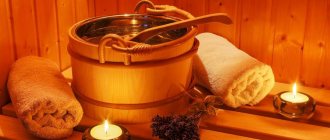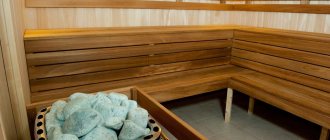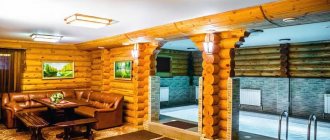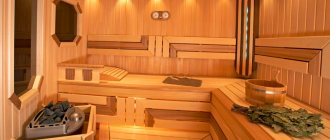“If there are brooms, an ice hole and tea, it’s a bathhouse, but when there’s vodka, barbecue and girls, it’s already a sauna.”
Greetings to all blog visitors!
There are many types of baths on earth. They are also found in Japan - Ofuro, Indonesia, Brazil and Mexico. Each relies on its own rituals and traditions. However, ours is both closer and dearer to us. But... still one of the “foreign” bathhouse cultures managed to put down strong roots on Russian soil.
This is a Finnish sauna. And sometimes disputes arise: what is better, more useful, more correct. To me, this is like an argument about women. Blondes or brunettes, how to choose? Therefore, today we’ll talk about the difference between a sauna and a bathhouse. Neutral comparison, without emotions, essentially...
The ancestor of both baths is a log hut.
By the way, the Finnish people are indigenous people from Western Siberia. More precisely, from the territories of the current Khanty-Mansiysk Okrug. They are not Scandinavians. From ours it became...
The main differences: humidity and air temperature
The most fundamental difference is the humidity of the steam: in the bath it is low temperature and humid, but in the sauna it is very hot and dry. The large amount of moisture-saturated steam in the air of a Russian bath is determined by some other features of these two rooms considered here. These include the design of the stoves and the method of heating the steam room.
It is worth noting that the low temperature of the bath (about 60°C) together with high humidity allows you to get several advantages at once:
- the absence of scalding hot air, which irritates and dries out the mucous membranes;
- the body in the bathhouse warms up much better, which promotes increased release of toxins and excellent normalization of the functioning of some internal organs;
- maximum humidity prevents droplets of water and sweat from evaporating from the surface of the skin, which protects the steamer from dehydration, which is dangerous for the body;
- The bathhouse is recommended for visiting by people with certain cardiovascular diseases and those who suffer from diseases of the upper respiratory tract (people of these categories are absolutely not allowed to go to the sauna).
Hot steam Source metropoles.com
For comparison: air humidity in a bathhouse is about 70% (from 50% to 90%), in a sauna it is about 20%; the temperature in the bathhouse is 60°C (on the top shelf it may be higher), in the sauna – 100°C and above. Thanks to such indicators, more natural and healthy conditions are observed in the bathhouse.
See also: Catalog of companies that specialize in the design, construction and arrangement of baths and saunas
Differences in ventilation
Another difference between a sauna and a Russian bath is the different organization of ventilation. Ventilation in the sauna outside and inside the steam room has the same pressure. The sauna steam room has excess pressure, which creates dry and superheated steam.
With increased pressure, it enters the steam room through a small hole in the stove. Some of the steam returns and the pressure in the furnace increases even more. Hot steam rises to the ceiling and draws cold air across the floor. You can also read how a hammam differs from a sauna and which of them is healthier.
Stones, steam and oven
When considering the problem “Sauna and bathhouse: what is the difference,” it is worth paying attention to the methods of heating and generating steam in these two rooms. Thus, a sauna requires the presence of an electric stove with stones placed on it, and in a bathhouse, in most cases, stones are placed inside and no electric heating elements are used, only natural aromatic firewood.
The stones in the steam room can be either open or closed. In the first case, it is very convenient to add water to them to add steam to the room. In the second case, that is, when the stones are closed behind closed oven doors, another advantage appears: the temperature of the hot stones is maintained for a longer period of time.
Stones in the bath Source yandex.net
Russian bath
The traditional Russian bathhouse originated a very long time ago. Initially, it was a small, squat hut, half sunk into the ground. It was built in such a way that the heat in the hut would remain longer.
On a note! The first baths in Rus' were heated only with black heat.
The black sauna was designed in such a way that the open stove-stove was located in the middle of the room and did not have a chimney. When it was heated, smoke spread through the hut, heating and disinfecting it. As a result, a lot of soot remained on the walls and ceiling, which is why this type of bathhouse has a corresponding name. This species has survived to this day, but only as a curiosity. The modern Russian bathhouse that we are talking about today has a slightly different appearance and features.
Features of the Russian bath
Modern Russian baths are equipped with stoves with a chimney. This is a safer and cleaner way to burn: there is no risk of carbon monoxide asphyxiation, and the walls and ceiling remain clean. There are debates about the cleanliness of the bathhouse in black and white - there is an opinion that the fumes have disinfecting properties. However, aesthetically, a bathhouse with clean rather than smoked walls is more attractive, which is why this type is the most popular in the country.
There are two main features of the Russian bathhouse, by which it can be instantly distinguished from others:
- The steam room and washing room are combined. So, almost the entire process takes place within one room: visitors steam, wash, and only then go to the dressing room and change clothes.
- High humidity. This feature follows from the first. Since a large amount of water is used indoors (to wash), the humidity increases significantly.
There are several other features that are best considered in a comparative manner.
Design differences
In the vast majority of cases, a Russian bathhouse is a free-standing wooden building (it is best to build it from coniferous wood), which has two rooms: a steam room or steam room itself and a dressing room, which serves as a locker room, a relaxation room and a hallway. The main part of the furnace is also located in this auxiliary room.
Steam room in the bath Source stroy-podskazka.ru
A sauna necessarily contains a swimming pool in its design, the function of which in the case of a bathhouse is replaced by a natural (or, in extreme cases, artificial) reservoir located in close proximity to the log house. Also in the sauna, in addition to the sweat room (analogous to a steam room), the changing room (analogous to a dressing room), there is a soap compartment.
Some visiting traditions
Russian bath
A broom is the main attribute. Different brooms have different effects. On the one hand, massage, on the other, the aroma released from steamed leaves under the influence of temperature.
You can move in the steam room. After leaving the steam room, you need to sit in the dressing room. Relax. About the pool??? Previously, baths were built near reservoirs, but now swimming pools are built in.
The benefits of the Turkish steam room
Hammam and sauna differ in the amount of wet vapor. While Finnish steam rooms are filled with dry air, Turkish baths maintain a humid microclimate. Due to the bath conditions, sweating is minimal, and the body gets wet due to the formation of condensation. The skin and hair do not dry out, so the hammam is a good alternative to the steam room for people suffering from allergies and increased sensitivity of the body. Despite the slight heating of the room, under the influence of moisture the pores expand faster.
It is advisable to arrange steam sessions in Turkish steam rooms:
- For people who prefer to accompany steam treatments with aromatherapy. The hammam provides the opportunity to visit the solarium.
- In order to strengthen the functioning of the heart and blood vessels.
- For complete warming up of muscles and joints.
- In order to relieve stress, conduct relaxation sessions.
- To combat the symptoms of bronchitis and runny nose at an early stage.
- For girls who want to thoroughly cleanse their skin pores of dirt.
- In order to normalize metabolism and rejuvenate the body. Weight loss occurs faster if you combine training and a balanced diet with a visit to the hammam.
Essential oils for aromatherapy
Infrared sauna
There are several types of saunas. For example, an Infrared sauna is a thermal treatment device in which a seated person is heated using infrared radiation rather than air. The heating method is the main difference between infrared saunas and other types of baths and saunas. A session in such a sauna usually lasts 30 minutes at an air temperature of only 37-47°C and natural humidity. Sweating in an infrared sauna is significantly higher than in conventional saunas and baths, under much milder conditions, which achieves a greater healing effect in relation to other saunas.
Heaters must produce such a flow of infrared energy that this energy can penetrate deep into the human body, and not just heat the upper layers of the skin. It is the radiation power of the heaters that distinguishes infrared cabins from other types of baths. The operating temperature of the heater surface must be at least 230-280°C; only at these temperatures can the required level of IR energy be achieved. Cabins containing low temperature heaters cannot be considered “infrared”. Because these heaters produce too little IR energy.
Temperature and humidity
Before starting a session in the infrared sauna, it is necessary to prepare it, i.e. create a certain microclimate. The air temperature inside the sauna before the start of the session should be at least 35-37°C, and the humidity no more than 45-50%. A person who is inside the cabin receives energy from the heaters, the internal body temperature rises and the thermal regulation system, trying to compensate for this temperature increase, begins the process of sweating. The air humidity inside the cabin is: at the beginning of the session 40% and rises to 60% by the end of the session.
The air temperature in an infrared sauna is not critical for hyperthermic procedures - a person is heated not with the help of hot air, but with the help of direct infrared radiation from the heaters. However, for a normal sweating session, the air temperature in the cabin must be above 35°C, because At lower air temperatures, the human body will cool down. At temperatures above 50°C, difficult conditions will be created for human well-being.
Cabin size
The minimum dimensions of the cabin are determined by the dimensions of the seated person. A sitting person of average height occupies an area of 60x70 cm. To comfortably accommodate a person, an area of at least 80x80 cm is required; in a smaller volume, the person will be cramped, and in some cases there will be a fear of confined spaces. Taking into account that the thickness of the cabin walls is 15 cm, we recommend making cabins with external dimensions of at least 95x95 cm.
Heaters
Heaters are installed on all sides of a person in order to cover the human body with infrared radiation as completely as possible, but their number cannot be increased, because this leads to an increase in the air temperature in the cabin:
- Corner (front) heaters are installed on the cabin floor in a vertical position to warm the shins and feet. Installing corner heaters at chest level leads to a decrease in heating efficiency, because in this case, the distance to the body increases beyond the norm. The foot heater is installed under the bench and serves to warm up the calf muscles.
- Rear heaters are installed behind a seated person. During the session, to warm up other parts of the body, you can turn sideways towards the heaters. Typically, five heaters are sufficient for a single cabin, and six for a double cabin.
Stages of sweating
There are 4 stages of sweating during a session in an infrared sauna:
- The first stage is energy accumulation, where internal energy is accumulated. At this stage, sweating is not significant. Duration – 7-10 minutes.
- The second stage is profuse sweating, in which the largest release of sweat is produced due to the removal of water from the subcutaneous space. Duration – 10-12 minutes.
- At the third stage, sweating decreases, because Almost all unbound water has already been removed from the body and the increase in internal body temperature accelerates. Duration – 7-10 minutes.
- The fourth stage begins after the end of the session and is characterized by a slight increase in sweating due to the energy accumulated by the body. Duration – 5-8 minutes.
Everything described above does not apply to panel cabins - you cannot warm up deeply and thoroughly in them.
What common
We looked at the difference between a bathhouse and a sauna. What do they have in common? The main task when visiting a sauna or bathhouse is to remove toxins from the body through the skin. The latter is achieved by maximally warming up the human body. Baths and saunas are the best places to relax and improve your health. Despite the significant differences between them, spending time in them gives a person a lot of positive emotions.
Despite the significant differences between a bathhouse and a sauna, spending time in them gives a person a lot of positive emotions
How to properly use essential oils in a bath
Staying in a sauna or steam bath in the nude has a medical basis. Exposure to high temperatures on the body provokes intense sweating. Sweat not only removes excess fluids, but also protects the skin from excessive overheating (drops of sweat cool the body). If you have clothes on your body, sweat is instantly absorbed and does not cool the skin. Because of this, the body may overheat. In young sauna visitors with strong blood vessels, it can pass without consequences, but people with excess body weight and hypertension are at risk. The Germans follow the recommendation to go naked to saunas (even public ones). Moreover, the first point of the rules that guests of a German sauna will see is: “Von der Kleidung verboten” (“No clothing allowed”). The democratic nature of the Germans is not entirely appropriate in a more conservative Russia. If you plan to go to the sauna with us, you should wear a more covered outfit than a hat and flip-flops.











